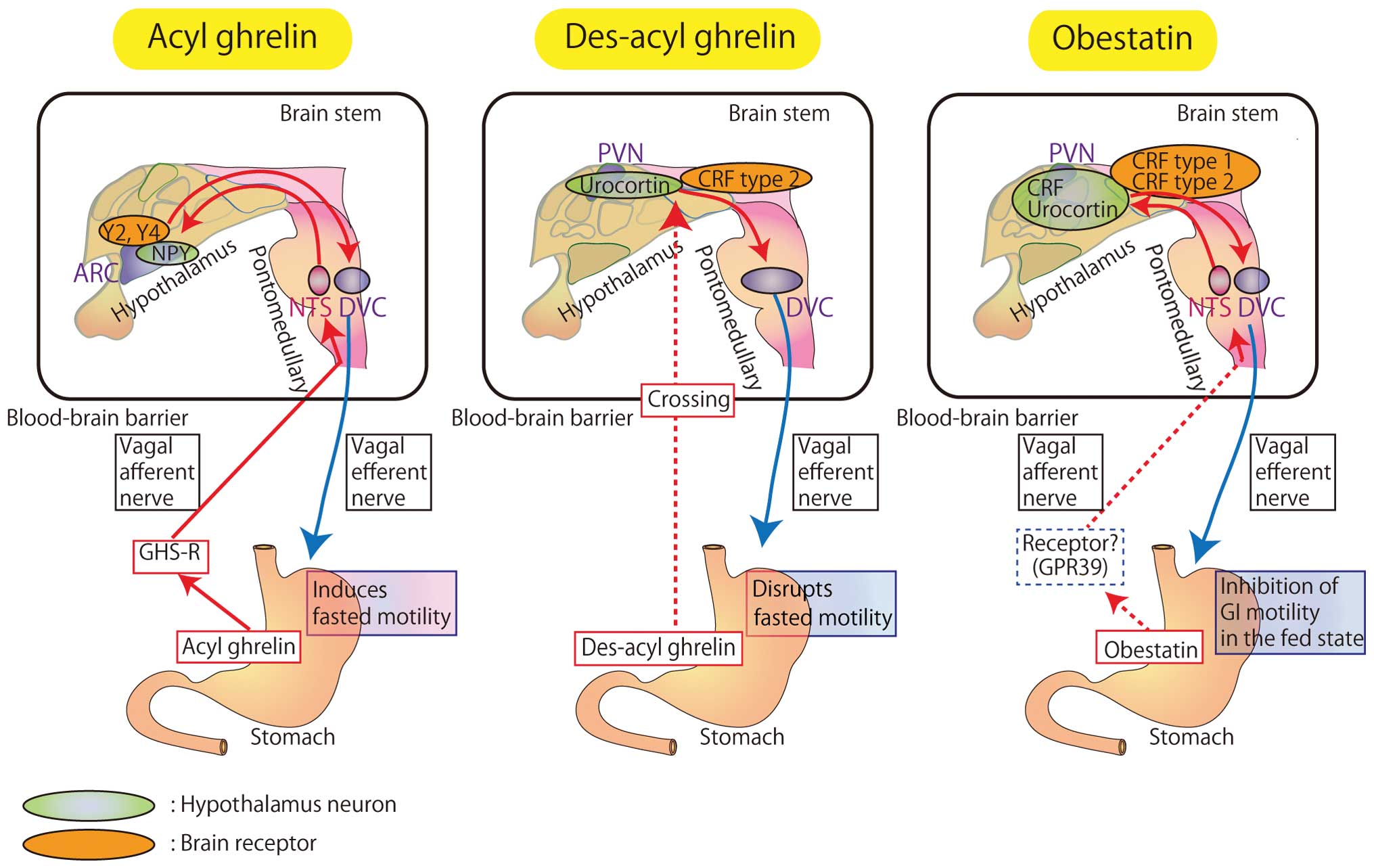DEFINITION
Ghrelin is a 28-amino-acid peptide produced primarily in the stomach and so called for its property of stimulating GH secretion in humans. Ghrelin stimulates food intake, exerts adipogenic activity and is involved in the long-term regulation of body weight . Ghrelin Kegg pathways
CHEMICAL STRUCTURE AND IMAGES
When relevant for the function
- Primary structure
- Secondary structure
- Tertiary structure
- Quaternary structure
Model


Ghrelin has high alanine, glutamate, alpha ketoglutarate that can derive from glucose. Hyperglycemia as a modulatorof Ghrelin level?
SYNTHESIS AND TURNOVER



Homeostatic regulation of food intake
mRNA synthesis

protein synthesis
post-translational modifications
Unacylated ghrelin rescues endothelial progenitor cell function in individuals with type 2 diabetes.2010
Ghrelin circulates in both
- acylated (AG)
- unacylated forms (UAG)
Historically, AG, usually referred to as ghrelin, has been considered the only active form of the peptide. It recognizes the Gq-coupled growth hormone secretagogue receptor type 1a, denoted as GHS-R1a (2), mediating its growth hormone–releasing properties as well as other significant neuroendocrine actions. In contrast, UAG does not bind the GHSR1a and is devoid of growth hormone secretagogue activity. Nevertheless, both AG and UAG share affinity for common binding sites that mediate vascular activities in terms of vasodilation and inhibition of cardiomyocyte and endothelial cell apoptosis. Furthermore, UAG effects, different from those elicited by AG, have also been demonstrated, suggesting the existence of an additional unidentified receptor for UAG.
Besides expression in several tissues, including the cardiovascular system, ghrelin is produced mostly by the stomach. In particular, in humans, AG reduces insulin sensitivity and exerts orexigenic activity, whereas UAG has opposite effects. Circulating total ghrelin levels are negatively associated with BMI, and ghrelin secretion is reduced in obese and type 2 diabetic individuals, possibly as a compensatory mechanism protecting against hyperglycemia. Interestingly, a relative excess of AG compared with UAG has been reported in clinical conditions marked by insulin resistance, raising the possibility that the altered UAG/AG ratio could play a role in the altered glucose metabolism and its ongoing
complications.
Among such complications, accelerated vascular disease is widely recognized as the major cause of disability and death in individuals with type 2 diabetes. Endothelial injury is thought to represent a crucial step in the initiation and progression of atherosclerotic vascular disease in this setting (13). Previous data support the central role of advanced glycosylation end products (AGEs) (14) and of NADPH oxidase–mediated reactive oxygen species (ROS) production in impaired vascular remodeling associated with diabetes (15). NADPH oxidase (Nox) consists of a membrane-bound catalytic subunit and several cytosolic regulatory subunits (p47phox and p67phox). Moreover, the GTPase-bound Rac1 is required for the functional assembly of the holoenzyme (15).
degradation
CELLULAR FUNCTIONS
cellular localization,

biological function
Ghrelin Target Tissues

Ghrelin affects multiple systems 2009
Ghrelin stimulates food intake by acting primarily on the arcuate nucleus of the hypothalamus. Ghrelin also exerts adipogenic activity, and is involved in the long-term regulation of body weight . Administration of ghrelin induced body weight gain and adiposity by stimulating food intake and reducing fat utilization and energy expenditure. Considering that ghrelin is involved both in short-term regulation of food intake, by stimulating appetite, and in long-term body-weight regulation, by inducing adiposity, the presence of this hormone in breast milk could be one of the factors through which breast-feeding may influence infant feeding behavior and body composition later in life.

The role of ghrelin in patients with functional dyspepsia and its potential clinical relevance, 2013
It modulates feeding behavior in response to glucose availability, in concert with Glucagon and Leptin

- Enzymes
- Cell signaling and Ligand transport
- Structural proteins
REGULATION

Is ghrelin a signal for the development of metabolic systems?, 2005
Ghrelin increases intracellular Ca(2+) concentration in the various hormone-producing cell types of the rat pituitary gland. 2012

Plasma ghrelin isoforms and gastric ghrelin O-acyltransferase expression are influenced by Helicobacter pylori status, 2012 HP eradication
h4- Acetylcholine
Vagal stimulation modulates inflammation through a ghrelin mediated mechanism in traumatic brain injury. 2012
furthermore, ghrelin release is stimulated by acetylcholine.
Acetylcholine regulates ghrelin secretion in humans. 2004
Gastric secretion. 2014
Stimulants of acid secretion include histamine, gastrin, acetylcholine, and ghrelin.
DIAGNOSTIC USE